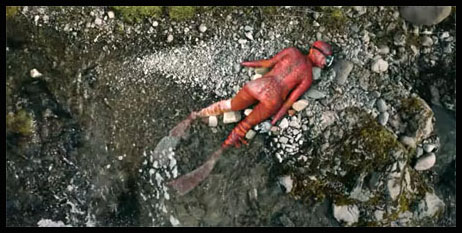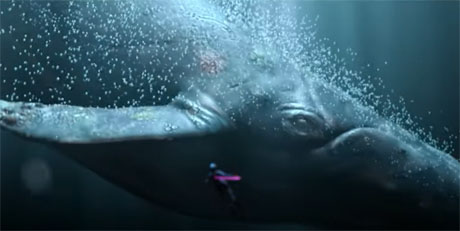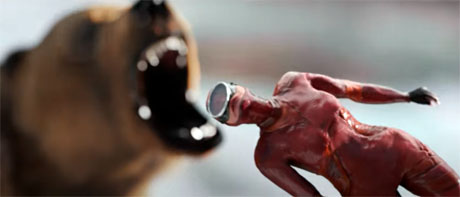
One of the 15 selections on this year’s Best Animated Short Film Oscars shortlist is Wild Summon, a fascinating *tail* of the life cycle of salmon, shown to us in human form. It’s an instantly captivating live-action / animation hybrid that screened at Cannes in May to rave reviews. The directing duo Karni & Saul provides insight on this bold creation in this Animation Scoop Email Q&A. (This interview was edited for length and clarity.)
Jackson Murphy: This is a fascinating saga we go on, presented in a compelling way. What were your goals with approaching this story?
K&S: The concept of Wild Summon is a sort of magic moment of inspiration. Representing an animal in a human form is the opposite of what animation usually does, which is to make animals with human characteristics animals that behave like humans. The goal was two-sided. On the one hand, to create empathy and engagement with an eco film, by giving a creature which is entirely different from us a human form. We tend to care more for things that look like us. In doing so, we hope to reconnect the audience with the natural world in fresh and groundbreaking ways — breaking the boundaries of natural history docs and fantasy. On the other hand, we wanted to remark on something wholly human. The images the film explores touch on social and political issues. Mass Immigration, refugees, war, violence against women, survival, the journey to home and so on. Lastly, the film is a sort of homage to motherhood. Carrying the heavier weight of creating the next generation, and in this fish’s case, giving her life in doing so. It’s looking at how we treat nature and each other, which seem to be intertwined, more than we imagine.

JM: It’s visually gorgeous. What were the challenges of making everything we see feel so real?
K&S: Thank you. The challenges are massive. We use 20 years’ worth of knowledge and a sharp eye for details, shortcuts and visual trickery and pleasure. In this film, water and crowd simulations were incredibly challenging as they are usually reserved for large studios and budgets. We tend to treat animation in a more live-action sense. We storyboard but then let some magic moments, light, and spontaneity leak in. We make sure the films are very photographic and filmic, as well as showing fantasy and beauty. It needs imperfections and details. That’s what we relate to as humans.
JM: You play very well with depth in the camerawork. What effort goes into that?
K&S: Interesting point. One of the biggest challenges visually in this film is size. When we see a human form, it’s tough for us to imagine it is the size of a fish—especially in its young age, where we are talking about a few millimeters. Depth of field works well to combat that, like a macro lens. Depth and focus planes are powerful cinematic language tools. Also, it goes back to being film and photographic. Using the language of beautiful cinematography and film stills. Sometimes, the grit, the imperfections and the things you don’t see clearly matter most, so you can empathise and connect.

JM: How did you want to make the experience of “Wild Summon” feel intense for the viewers?
K&S: By using every tool at our disposal — lighting, editing, music and animation. Creating an exciting road trip but in water. The storyline is built as a sequence of traumatic and beautiful yet challenging events in the life of the salmon, with a short relief and a breath at the end of each one. As we near the end of the film, the stakes go higher: The bear scenes, the crowded river frozen moment scene and so on. Basically, it’s stealing the salmon’s story and gifting it to the human. So all the turmoil, hardships and beauty become this surreal tale of survival.
JM: How do you feel about the survival/environment of creatures today?
K&S: Well, the survival of humans and nature are much more interconnected than people think. And that separation might be part of the problem. We think there has to be much more storytelling and films on the topic to try and highlight and bring change. We do believe that an emotional connection to nature is a forgotten key. By having a disconnection from nature to our everyday life (by living surrounded by seemingly unnatural products), we are shooting our foot. Everything is nature, especially us humans. Humans are part of nature.

JM: In making this short, what did you discover about the life cycle of nature
K&S: The life cycle of the salmon was one of the biggest draws for us. We all live in a sort of cycle. Many of us are drawn back to the places we were born. We tend to cycle our problems and relationships, but nothing is as perfectly formed as the life of the salmon. Born in a tiny, remote stream, it travels to the ends of the world and somehow manages to navigate itself back to the exact same place to give life to a new generation whilst ending its own life in the process. No one knows how; there are many theories. A sense of memory, smells, magnets, nature is magic, and of course, when man intervenes with pollution and dams and neglect and overfishing and fish farms, there is less and less chance of survival for these amazing creatures. The salmon is the canary in the coal mine. When something is up, when the balance is off, it goes first.
For the shoot: We travelled around Iceland to film the plates. We wanted live-action rivers to connect people to the real places to care. We also travelled in a circular path around Iceland, following the salmon around, filming as we went, immersing ourselves in rivers, streams and oceans. We were doing method directing. We tried to become fish. To see how it was to be a fish.
JM: How WILD would an Academy Award nomination be?
K&S: It would be absolutely wild, and we would be honored to be SUMMON-ed to the City of Angels.
- INTERVIEW: The Harmony Of “Acoustic Rooster And His Barnyard Band” - April 21, 2025
- INTERVIEW: Up Up And Away With “Super Duper Bunny League” - April 18, 2025
- INTERVIEW: Keith David And Rico Rodriguez Lace Up For “Sneaks” - April 16, 2025


 December 28th, 2023
December 28th, 2023  Jackson Murphy
Jackson Murphy  Posted in
Posted in  Tags:
Tags: 






